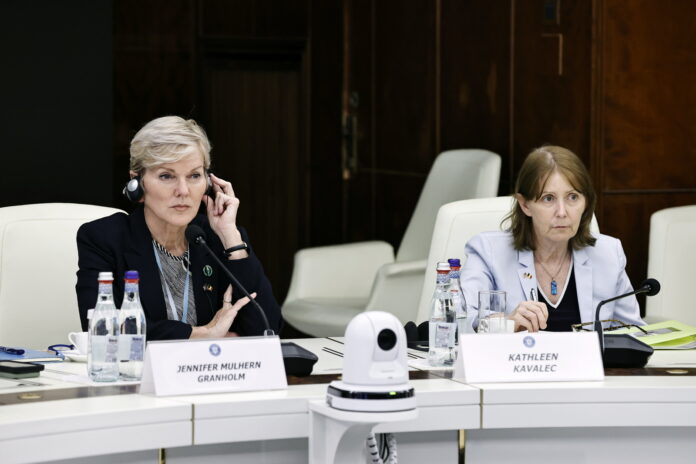The transition to clean energy is about much more than budgets and profits, and getting to net zero emissions by 2050 is not an option, it is a necessity, U.S. Secretary of Energy Jennifer Granholm told the Ministerial Meeting of the Partnership for Transatlantic Energy and Climate Cooperation (P-TECC) on Wednesday.
„As this conflict [in Ukraine] has laid bare, the clean energy transition is about so much more than budgets and bottom lines, not only for the people of Ukraine, but for this other foe. This other foe that we have created ourselves as humans, which is climate change. That foe is attacking every corner of the world. For the mother and her daughters who were trapped in their home in floods in Slovakia, the family who lost their home in wildfires in Cyprus, for the child facing heat exhaustion as temperatures soar in Austria. Our success in this transition is a matter of life and death. Reaching net zero by 2050 is not an option, it’s a necessity, an imperative, and we need to do this work, as you all know, right now, if we’re going to get there,” the U.S. official said.
She reiterated that the United States is implementing unprecedented strategy for clean energy. „For our part, the United States is delivering on really an unprecedented industrial strategy. I went over this a bit yesterday, but it’s worth just underscoring how unique it is for us as a nation and how successful it has been to be able to do the investments in both research and development, demonstration and deployment of clean energy technologies,” she said.
„We’re also making real strides not just on the economy and taking advantage of this new sector, but in the climate fight itself, for in the United States by 2030, we are on pace to double the share of our electricity that is generated by clean sources and to slash our emissions by 40%, just by virtue of the laws that were passed under the Biden-Harris administration. If you add on what states and what the private sector are doing, we are on track to slash our emissions by 50%. That is terrific. More importantly, we’re on pace to prevent 18,000 deaths from air pollution, 118,000 asthma attacks, and of course globally, the story is the same. Together, we added more than 500 gigawatts of renewable energy in 2023, setting a new record for this 22nd year in a row. People registered more than 250,000 electric vehicles every week last year, more than the annual 10 years ago. And solar and wind capacity continue to just skyrocket, on track to triple in the next decade. I mean, to put these numbers in perspective, and I appreciate the knowledge curve that you shared, Minister, but the first commercial renewable power plant was built over 100 years ago. In the next five years alone, the world is on track to add more renewable capacity than we have had since that plant came online. In other words, five years to make a century of progress,” Jennifer Granholm said.
She added that, according to the International Energy Agency – IEA, we need to invest trillions in clean energy every year through 2030 to achieve a successful transition.
„We have to add or replace over 80 million kilometers of transmission and distribution infrastructure by 2040, the equivalent length of the entire existing global grid. We have to think differently about the grid infrastructure. It is akin to the transportation corridors, to the road and highway infrastructure. We need to invest in it like that. That piece of infrastructure is so critical. And we have to seriously build out the clean energy workforce. We need a million electricians by the early 2030s. And that’s just electricians. So these are no small tasks. But with strong Atlantic partnerships like P-TECH, with continued public-private cooperation, I’m confident we can get the job done, the U.S. Secretary of Energy also said.
Granholm brought to mind that the U.S. signed an intergovernmental agreement with Bulgaria to build a new large-scale nuclear reactor, following similar intergovernmental agreements with Poland and Romania.
AGERPRES




